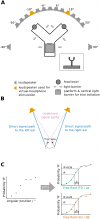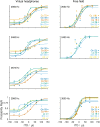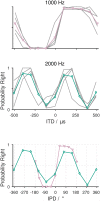Exploring binaural hearing in gerbils (Meriones unguiculatus) using virtual headphones
- PMID: 28394906
- PMCID: PMC5386270
- DOI: 10.1371/journal.pone.0175142
Exploring binaural hearing in gerbils (Meriones unguiculatus) using virtual headphones
Abstract
The Mongolian gerbil (Meriones unguiculatus) has become a key species in investigations of the neural processing of sound localization cues in mammals. While its sound localization has been tested extensively under free-field stimulation, many neurophysiological studies use headphones to present signals with binaural localization cues. The gerbil's behavioral sensitivity to binaural cues, however, is unknown for the lack of appropriate stimulation paradigms in awake behaving gerbils. We close this gap in knowledge by mimicking a headphone stimulation; we use free-field loudspeakers and apply cross-talk cancellation techniques to present pure tones with binaural cues via "virtual headphones" to gerbils trained in a sound localization task. All gerbils were able to lateralize sounds depending on the interaural time or level difference (ITD and ILD, respectively). For ITD stimuli, reliable responses were seen for frequencies ≤2.9 kHz, the highest frequency tested with ITD stimuli. ITD sensitivity was frequency-dependent with the highest sensitivity observed at 1 kHz. For stimuli with ITD outside the gerbil's physiological range, responses were cyclic indicating the use of phase information when lateralizing narrow-band sounds. For ILD stimuli, reliable responses were obtained for frequencies ≥2 kHz. The comparison of ITD and ILD thresholds with ITD and ILD thresholds derived from gerbils' free-field performance suggests that ongoing ITD information is the main cue for sound localization at frequencies <2 kHz. At 2 kHz, ITD and ILD cues are likely used in a complementary way. Verification of the use of the virtual headphones suggests that they can serve as a suitable substitute for conventional headphones particularly at frequencies ≤2 kHz.
Conflict of interest statement
Figures







Similar articles
-
Interaction of interaural cues and their contribution to the lateralisation of Mongolian gerbils (Meriones unguiculatus).J Comp Physiol A Neuroethol Sens Neural Behav Physiol. 2018 May;204(5):435-448. doi: 10.1007/s00359-018-1253-5. Epub 2018 Feb 23. J Comp Physiol A Neuroethol Sens Neural Behav Physiol. 2018. PMID: 29476321
-
Resolution in azimuth sound localization in the Mongolian gerbil (Meriones unguiculatus).J Acoust Soc Am. 2006 Feb;119(2):1029-36. doi: 10.1121/1.2159429. J Acoust Soc Am. 2006. PMID: 16521765
-
Effects of omni-directional noise-exposure during hearing onset and age on auditory spatial resolution in the Mongolian gerbil (Meriones unguiculatus) -- a behavioral approach.Brain Res. 2008 Jul 18;1220:47-57. doi: 10.1016/j.brainres.2008.01.083. Epub 2008 Feb 12. Brain Res. 2008. PMID: 18343357
-
[Sound localization cues of binaural hearing].Laryngorhinootologie. 2003 Apr;82(4):240-8. doi: 10.1055/s-2003-38932. Laryngorhinootologie. 2003. PMID: 12717598 Review. German.
-
In praise of adventitious sounds.Hear Res. 2022 Nov;425:108592. doi: 10.1016/j.heares.2022.108592. Epub 2022 Jul 28. Hear Res. 2022. PMID: 35945069 Review.
Cited by
-
Altered cochlear innervation in developing and mature naked and Damaraland mole rats.J Comp Neurol. 2019 Oct 1;527(14):2302-2316. doi: 10.1002/cne.24682. Epub 2019 Mar 25. J Comp Neurol. 2019. PMID: 30861124 Free PMC article.
-
Developmental fine-tuning of medial superior olive neurons mitigates their predisposition to contralateral sound sources.PLoS Biol. 2024 Apr 29;22(4):e3002586. doi: 10.1371/journal.pbio.3002586. eCollection 2024 Apr. PLoS Biol. 2024. PMID: 38683852 Free PMC article.
-
Pup ultrasonic isolation calls of six gerbil species and the relationship between acoustic traits and body size.R Soc Open Sci. 2021 Mar 3;8(3):201558. doi: 10.1098/rsos.201558. R Soc Open Sci. 2021. PMID: 33959325 Free PMC article.
-
Age-Related Deficits in Binaural Hearing: Contribution of Peripheral and Central Effects.J Neurosci. 2024 Apr 17;44(16):e0963222024. doi: 10.1523/JNEUROSCI.0963-22.2024. J Neurosci. 2024. PMID: 38395618 Free PMC article.
-
Associated tympanic bullar and cochlear hypertrophy define adaptations to true deserts in African gerbils and laminate-toothed rats (Muridae: Gerbillinae and Murinae).J Anat. 2019 Feb;234(2):179-192. doi: 10.1111/joa.12906. Epub 2018 Nov 25. J Anat. 2019. PMID: 30474264 Free PMC article.
References
MeSH terms
LinkOut - more resources
Full Text Sources
Other Literature Sources
Miscellaneous

